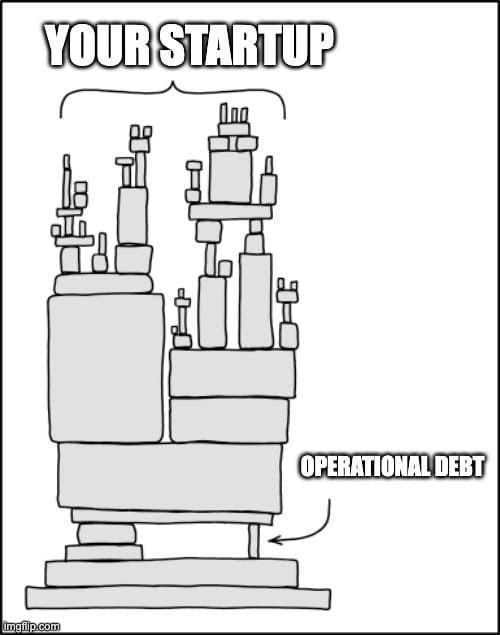What is Operational Debt for a Startup and Scaleups?
And why identifying it per stages helps you grow more sustainable
Every startup accumulates operational debt, it's part of the growth process. Just like legacy systems and technical debt, operational debt involves the shortcuts and compromises made in a company's operations:
Hastily implemented procedures
insufficient training or outdated skills
Outsourcing vs. building an internal team
Processes implemented by someone no longer within the company
Neglected documentation (contracts, commission structures, role descriptions, etc)
Outdated terminologies and definitions within the company
“Short-term hacks” that remain in place, never cleaned up or updated
These "good enough for now" decisions eventually start to weigh down your company's progress.
Everything outside financial debt and technical debt falls under operational debt. Think marketing debt, go-to-market debt, sales debt, hiring debt, talent debt, culture debt, and so on. You get the point.
A helpful definition is: Operational debt is the hidden accumulation of unresolved choices that, over time, cumulatively undermine and weaken organisational effectiveness and success.
In simpler terms, it's debt that must be repaid, repaired, or rebuilt.
When you make short-term decisions, you are borrowing resources from the future. Eventually, you’ll have to pay—whether in money or, worse, in time.
If operational debt becomes too severe, it can derail your startup. Sometimes, it's hard to pinpoint what went wrong or what caused the derailment. Rebuilding takes time, which is why startups often pivot or undergo transformations—these processes can be painful.
The Startup Founder’s Dilemma: Speed vs. Scalability
As a founder, you're constantly balancing speed with operational scalability, much like the project management triangle of scope, cost, and time.
The Key Lesson: You need to understand where your company is on its journey and identify the operational debt specific to that stage. This awareness helps you avoid unsustainable and unmanageable debt that could derail your progress.
If you don’t, failure is inevitable—you just might not realise it yet.
Examples of missteps:
Fundraising when you're not ready
Expanding internationally before you're equipped to handle it
Premature GTM acceleration
Hiring C-level leaders while your product is still in development
Launching a go-to-market strategy without proving product-market fit (PMF)
This is where the experience of a serial entrepreneur shines through. They understand how critical it is to get the fundamentals right before moving forward.
When you reach the next stage, it's time to pay off the operational debt. What worked yesterday won't work today. Time to pay up.
This is where the additional work of repaying, repairing, or rebuilding begins.
Company Lifecycle stages from https://www.adizes.com/organizational-lifecycle
Normal Problems vs. Abnormal Problems
As we mentioned earlier, operational debt is normal. No one can perfectly manage systems, projects, workforce, and data—it’s unrealistic.
However, it's essential to differentiate between normal problems and abnormal problems based on your company’s stage.
Normal problems are desirable because they represent learning opportunities. These are the challenges that help you grow. You need normal problems.
Abnormal problems, on the other hand, should be avoided or addressed quickly. Left unchecked, they slow you down, derail your progress, or become unmanageable.
How to Address Operational Debt
There are two approaches:
Be perfect with the fundamentals: This means having excellent systems, processes, data quality, and people management. While difficult, it is possible—though startups often face trade-offs between speed and scalability. I’ll cover this approach, called "smart systematic entrepreneurship" in my upcoming blog post.
Operational Debt Assessments: At each stage of your company’s growth, take a moment—like a pit stop—to identify operational debt and rank your normal and abnormal problems. Set timelines (e.g., 1 month, 3 months, 6 months) for addressing the abnormal problems before moving to the next stage.
Document everything.
Bring in external experts, ideally serial entrepreneurs who’ve seen many companies and can help identify abnormal problems and assess operational debt.
Share the operational debt assessment with your investors to demonstrate how you plan to “repay, repair, rebuild” before moving forward. This helps focus efforts.
Invest in ongoing training and development for your team to fill gaps and boost performance.
Evaluate the 7 Parallel Development Tracks within your company to determine what’s developed, what’s underdeveloped, and what’s missing.
7 Parellel Development Tracks - Maturity Organisation
We developed the 7 Parallel Development Tracks to assess an organisation's maturity across different company stages and milestones.
Business:
Market & Communication
Sales & Customers
Assets:
Product
Technology & Ops
Enablers
Finance & Legal
People & Culture
Self - Founder(s)*
*We believe that the personal development of the founder(s) is crucial to the growth of the organisation. It impacts hiring, strategic direction, decision-making, and company culture. If the founder(s) are not sufficiently developed or upskilled, they risk slowing down the company's progression to the next stage. For this reason, we consider this a separate, parallel development track.
7 Parallel Development Tracks
Maturity levels
Balancing Short-Term and Long-Term Success
It’s often difficult to get attention on operational debt within a company, and no one enjoys assessments. However, they are increasingly crucial for survival. Founders who have undergone rigorous due diligence for fundraising understand its importance.
As a startup founder, you need to balance short-term fire fighting with long-term vision. If you borrow too much in the short term with quick fixes, you’ll eventually pay the price.
If you’re interested in an Operational Debt Assessment, let me know—we're mapping this out specifically for Seed and Series A startups. Both software and hardware startups. → https://x.com/sabben or www.petervansabben.com







